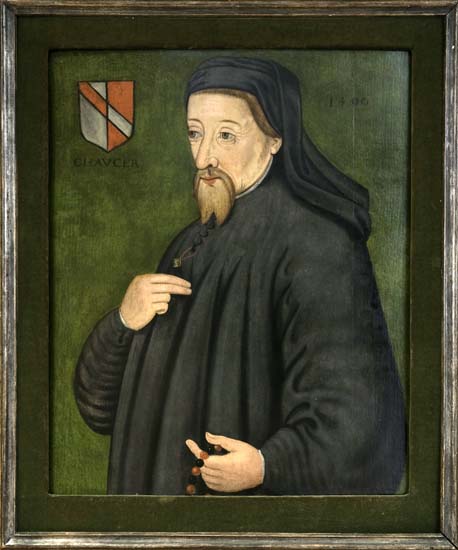While a sweet April shower was coming down outside, English Professor Michael Allen stood perfectly dry and silent in the English Reading Room, fixed on a portrait in a display, studying its features.
Leaning closer to the glass, he squinted, then spoke softly out of respect for either the reading room’s rules or the portrait’s eminence.
“It’s very difficult to date paintings on wood panels,” he said with a grin. “That is why it may not be possible to accurately date the oldest portrait of Geoffrey Chaucer.”
In two sentences, Allen summed up the debate surrounding the age of the English department’s antique, an oak panel painting of 14th-century poet Geoffrey Chaucer, the father of English poetry.
The portrait was purchased for UCLA in London in 1959 by university librarian Lawrence Clark Powell, the namesake of the College Library, and hung in various rooms in the department until members of the English faculty began to wonder about its provenance and started to do a little research.
UCLA’s Chaucer, some faculty argue, could be a contemporary of some of the oldest known Chaucer portraits.
Though he was not the first in the department to examine the portrait, former Professor Edward Condren’s research and writing on the UCLA Chaucer is among the most extensive to date.
But dating the portrait is indeed an enigmatic enterprise.
Condren has based his dating of the painting ““ sometime in the 1400s ““ on a few pieces of evidence, the first of which, he said, is perhaps the most convincing and the most detrimental to his argument.
“When I started working with the portrait, the first thing that occurred to me was, “˜Why in the hell should there be a portrait of Geoffrey Chaucer from that time?'” he said, referring to the marking of 1400 in the upper right corner of the portrait, put there to denote the year of Chaucer’s death. “The literati have never been influential in any age. They only become important long after their deaths.”
Though carbon dating of the oak on which the portrait is painted indicates that 1400 might not be all that far off, and the paint used seems to corroborate the year as well, other considerations, including the style of portraiture, have raised skepticism.
Condren said that many of the details of the portrait seem to suggest that its painter was a student ““ perhaps one skilled at painting caricatures, explaining details such as the beads worn by the figure in the portrait ““ giving an explanation for why the portrait might have been done earlier in the 15th century.
His theory rests on a bit of historical context: Artists trained to illustrate and draw caricatures were learning to paint more formal portraits at the time in order to satisfy growing demand for the developing form.
UCLA’s Chaucer, Condren said, might be one such painting.
Colleagues acknowledge the rigorous study and well-formed arguments in Condren’s work, but many said his numbers may be a little ambitious.
Former UCLA English Professor Derek Pearsall has expressed doubts regarding Condren’s dating in print, and Andy Kelly, a close friend of Condren’s and also a former UCLA English professor, said he finds Condren’s arguments to be interesting, but nonetheless worthy of scrutiny.
The debate surrounding UCLA’s Chaucer is limited largely to the campus on which it resides. Practically all of the academics who have written about the portrait or Condren’s claims have been affiliated with UCLA, and its strongest admirers and auditors are the eldest members of the English faculty.
Admiration and curiosity among faculty have taken the portrait on a bit of a tour over the years, too.
Condren said he kept the portrait in his study at home for a couple of years while he was researching its age, and another former UCLA medievalist and administrator, former Vice Chancellor William Schaefer, had the portrait moved to his office in Murphy Hall when he changed offices during a seven-year stint as head of the Modern Language Association.
Schaefer was not doing research on the portrait, Condren said.
It was Condren, in fact, who reminded Schaefer that the portrait should stay in a communal space for the department and students especially to appreciate.
“We were talking about it for some time and he knew that it shouldn’t be in his office, where only he can appreciate it that much,” said Condren of Schaefer. “He realized that it might be considered one of the treasures of the English department. He didn’t know. Nobody knows, really, still to this day, whether it’s a treasure. We just know that we don’t want to throw it away, for God’s sake.”
